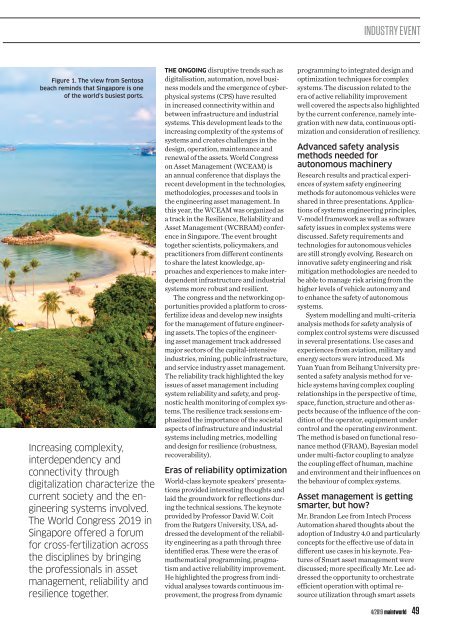Maintworld 4/2019
Machine Learning – Not a Gold-Plated Silver-Bullet Solution to Operational Woes // A Data-Driven Approach to Online Monitoring of Roller Bearings // Using Ultrasound to Enhance Energy Efficiency
Machine Learning – Not a Gold-Plated Silver-Bullet Solution to Operational Woes // A Data-Driven Approach to Online Monitoring of Roller Bearings // Using Ultrasound to Enhance Energy Efficiency
You also want an ePaper? Increase the reach of your titles
YUMPU automatically turns print PDFs into web optimized ePapers that Google loves.
INDUSTRY EVENT<br />
Figure 1. The view from Sentosa<br />
beach reminds that Singapore is one<br />
of the world’s busiest ports.<br />
Increasing complexity,<br />
interdependency and<br />
connectivity through<br />
digitalization characterize the<br />
current society and the engineering<br />
systems involved.<br />
The World Congress <strong>2019</strong> in<br />
Singapore offered a forum<br />
for cross-fertilization across<br />
the disciplines by bringing<br />
the professionals in asset<br />
management, reliability and<br />
resilience together.<br />
THE ONGOING disruptive trends such as<br />
digitalisation, automation, novel business<br />
models and the emergence of cyberphysical<br />
systems (CPS) have resulted<br />
in increased connectivity within and<br />
between infrastructure and industrial<br />
systems. This development leads to the<br />
increasing complexity of the systems of<br />
systems and creates challenges in the<br />
design, operation, maintenance and<br />
renewal of the assets. World Congress<br />
on Asset Management (WCEAM) is<br />
an annual conference that displays the<br />
recent development in the technologies,<br />
methodologies, processes and tools in<br />
the engineering asset management. In<br />
this year, the WCEAM was organized as<br />
a track in the Resilience, Reliability and<br />
Asset Management (WCRRAM) conference<br />
in Singapore. The event brought<br />
together scientists, policymakers, and<br />
practitioners from different continents<br />
to share the latest knowledge, approaches<br />
and experiences to make interdependent<br />
infrastructure and industrial<br />
systems more robust and resilient.<br />
The congress and the networking opportunities<br />
provided a platform to crossfertilize<br />
ideas and develop new insights<br />
for the management of future engineering<br />
assets. The topics of the engineering<br />
asset management track addressed<br />
major sectors of the capital-intensive<br />
industries, mining, public infrastructure,<br />
and service industry asset management.<br />
The reliability track highlighted the key<br />
issues of asset management including<br />
system reliability and safety, and prognostic<br />
health monitoring of complex systems.<br />
The resilience track sessions emphasized<br />
the importance of the societal<br />
aspects of infrastructure and industrial<br />
systems including metrics, modelling<br />
and design for resilience (robustness,<br />
recoverability).<br />
Eras of reliability optimization<br />
World-class keynote speakers’ presentations<br />
provided interesting thoughts and<br />
laid the groundwork for reflections during<br />
the technical sessions. The keynote<br />
provided by Professor David W. Coit<br />
from the Rutgers University, USA, addressed<br />
the development of the reliability<br />
engineering as a path through three<br />
identified eras. These were the eras of<br />
mathematical programming, pragmatism<br />
and active reliability improvement.<br />
He highlighted the progress from individual<br />
analyses towards continuous improvement,<br />
the progress from dynamic<br />
programming to integrated design and<br />
optimization techniques for complex<br />
systems. The discussion related to the<br />
era of active reliability improvement<br />
well covered the aspects also highlighted<br />
by the current conference, namely integration<br />
with new data, continuous optimization<br />
and consideration of resiliency.<br />
Advanced safety analysis<br />
methods needed for<br />
autonomous machinery<br />
Research results and practical experiences<br />
of system safety engineering<br />
methods for autonomous vehicles were<br />
shared in three presentations. Applications<br />
of systems engineering principles,<br />
V-model framework as well as software<br />
safety issues in complex systems were<br />
discussed. Safety requirements and<br />
technologies for autonomous vehicles<br />
are still strongly evolving. Research on<br />
innovative safety engineering and risk<br />
mitigation methodologies are needed to<br />
be able to manage risk arising from the<br />
higher levels of vehicle autonomy and<br />
to enhance the safety of autonomous<br />
systems.<br />
System modelling and multi-criteria<br />
analysis methods for safety analysis of<br />
complex control systems were discussed<br />
in several presentations. Use cases and<br />
experiences from aviation, military and<br />
energy sectors were introduced. Ms<br />
Yuan Yuan from Beihang University presented<br />
a safety analysis method for vehicle<br />
systems having complex coupling<br />
relationships in the perspective of time,<br />
space, function, structure and other aspects<br />
because of the influence of the condition<br />
of the operator, equipment under<br />
control and the operating environment.<br />
The method is based on functional resonance<br />
method (FRAM), Bayesian model<br />
under multi-factor coupling to analyze<br />
the coupling effect of human, machine<br />
and environment and their influences on<br />
the behaviour of complex systems.<br />
Asset management is getting<br />
smarter, but how?<br />
Mr. Brandon Lee from Intech Process<br />
Automation shared thoughts about the<br />
adoption of Industry 4.0 and particularly<br />
concepts for the effective use of data in<br />
different use cases in his keynote. Features<br />
of Smart asset management were<br />
discussed; more specifically Mr. Lee addressed<br />
the opportunity to orchestrate<br />
efficient operation with optimal resource<br />
utilization through smart assets<br />
4/<strong>2019</strong> maintworld 49

















